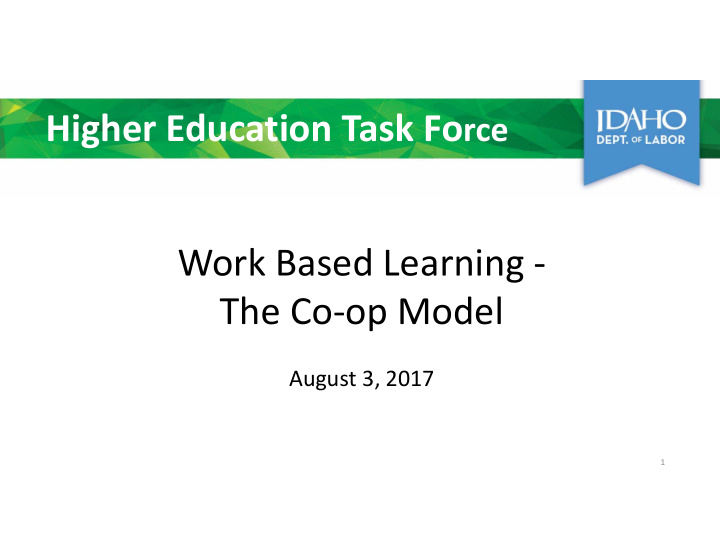



Higher Education Task Fo rce Work Based Learning ‐ The Co‐op Model August 3, 2017 1
The Match between Education and Employment Students ‐ barriers to post‐secondary education • Access and affordability • Proven value and relevance Employers – experiences with graduates • Lack of career readiness • Skills match – the real issue • Other issues • Student‐to‐business awareness • Retention of graduates in Idaho 2
Work‐Based Learning as A Solution • Project‐based learning • Internships • Co‐op • Examples in the US • University of Cincinnati – 1800 co‐op students across 45 majors with >1500 participating employers • 95 percent of co‐op students have jobs immediately upon graduation • Oregon – MECOP (Multiple Engineering Co‐op Program) • Oregon State, Portland State, Oregon Tech and Univ. of Portland • 5 year degree, two 6‐month placements • ~150 participating employers • Drexel – 1600 employers • Students do 3 work terms of 6 months each • Average work term pay is $16k • Northeastern • University of Waterloo, Ontario, Canada 3
The University of Waterloo Background Information • 19,000 co‐op students with >7,000 participating employers • Region had only 50 tech firms in 1997 ‐ now >1,000 that collectively generate ~$37 billion in annual revenue • Google, SAP, other tech companies have built large local offices to access Waterloo students • Waterloo is 2 nd biggest supplier of Silicon Valley talent despite being 3000 miles away • Most eventually return, many start companies 4
The University of Waterloo How does the Waterloo Co‐op work? • Undergraduate students complete at least one semester of core courses, then alternate between school semesters and work semesters – work time = 30‐50% of academic time • During work semesters, students are FTEs at participating employers ‐ can relocate as needed • Universities facilitate match‐making, logistics • Students expected to graduate in 5 years with up to 2 years of full‐time employment experience across multiple employers 5
The University of Waterloo Other key points about the Waterloo so‐op program • 20‐to‐1 applicant acceptance ratio • Required for engineering majors • Some internships promote entrepreneurship • Staff support – 173 people • Employers required to follow strict guidelines 6
The Co‐Op Model Benefit to business community • Access to recruits, especially from distant universities • Workforce development – attract top students to universities/employers and integrate them into companies • Predictability – employers can create and fill meaningful FTE positions with established duties rather than odd‐job internships with limited, erratic hours • Magnet for new business investment and start‐ups 7
The Co‐Op Model Benefit to students • Ability to work anywhere in the state • No need to balance school with work • Top‐quality, career‐relevant jobs lined up • Pay for school ‐ Waterloo model ‐ students generally graduate debt‐free with all expenses covered as they go • Better understanding of relevance of classwork • Opportunity to sample different jobs / employers / locations • Graduate with vastly better workplace skills, higher earning potential, better job opportunities 8
Recommend
More recommend